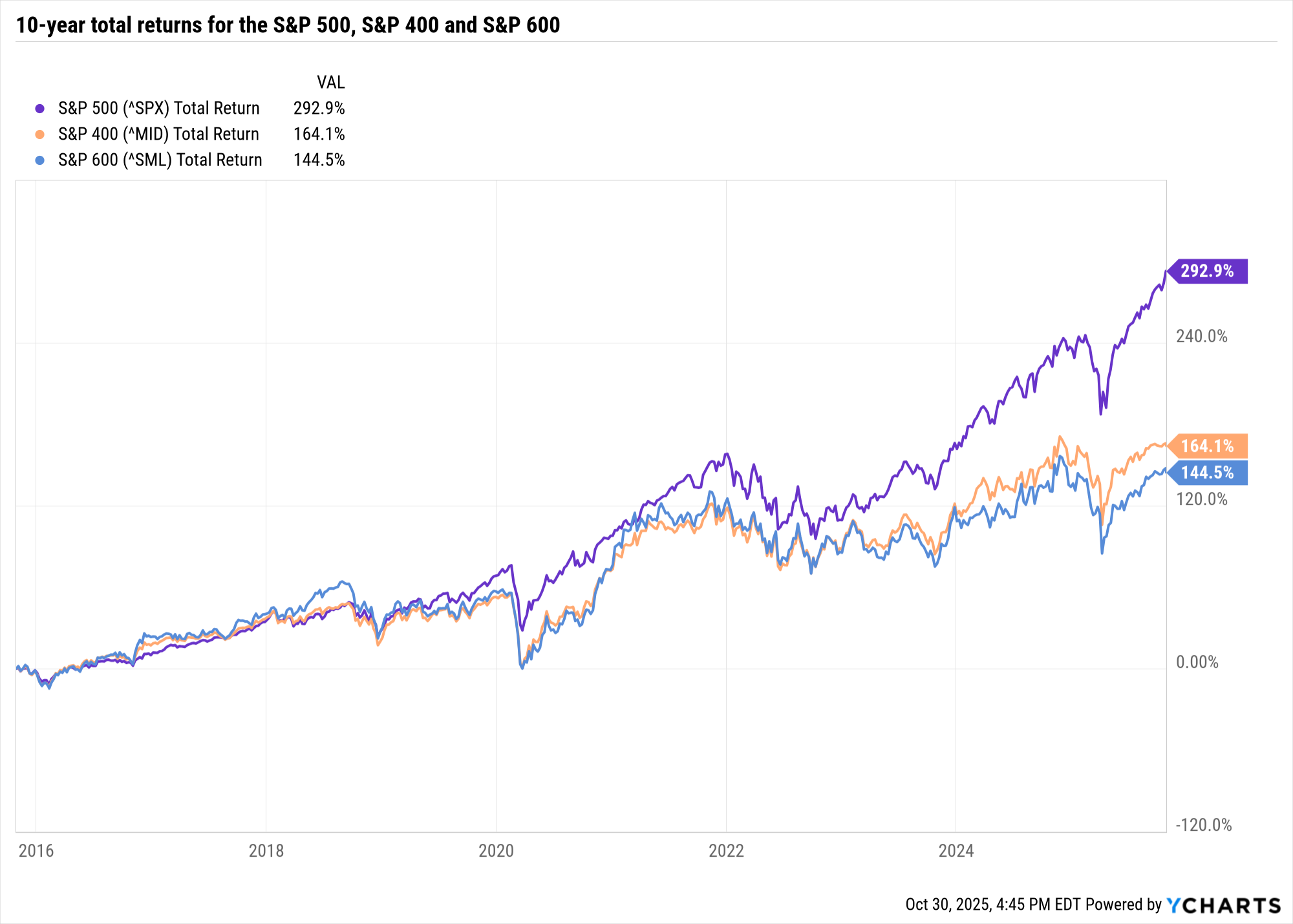
If you read investing articles or watch CNBC, you'll find that coverage is largely skewed in favor of both ends of the market-cap spectrum.
Financial media outlets will write a story a day on the likes of mega-cap giants such Nvidia (NVDA) or Apple (AAPL). But given their propensity for massive single-day moves, small-cap companies will often draw some spotlight, too.
Today, however, we're going to give the market's "middle child" its due.
Read on as we discuss mid caps – specifically, what they are, why you'd want to invest in them, and how to find the best mid-cap stocks to buy.
The investing community has a funny way of agreeing on terminology in the abstract, but failing to come together when it's time to discuss specifics.
Broadly speaking, mid-cap stocks are those companies that aren't quite as big as large-cap stocks, but are bigger than small-cap stocks. Pretty much what you'd expect.
What exactly does that look like?
The market cap ranges vary depending on who's talking about them. If you look around, you'll see suggestions of $5 billion to $20 billion, $10 billion to $20 billion … heck, American Century says they're between $11 billion and $65 billion.
And the Russell MidCap Index doesn't even assign a specific dollar value. Instead, it views the mid-cap world (at least in the U.S.) as stocks that rank 201 through 1,000 by market cap, whatever those market caps might be.
However, like many financial outlets, we've long held that mid-cap stocks are companies with market capitalizations that fall between $2 billion and $10 billion. So a little later, when we show you how to search for mid caps, that's the range we're working with.
Whatever numbers you prefer, when you're dealing with mid-cap stocks, they're the middle" of the market-cap world, which is they are often referred to as "Goldilocks stocks."
Why Goldilocks? We'll assume everyone is familiar with the story of Goldilocks and the three bears. The moral of the story is that you'll usually find happiness in between two extremes. I don't think that applies to every aspect of life, but the lesson certainly rings true with mid-cap stocks, which, from a performance perspective, are "just right."
Historically speaking, anyway.
Company (ticker) |
Market cap |
Long-term EPS growth rate |
Estimated annual revenue growth (2 years) |
Analysts' consensus recommendation |
Clear Secure (YOU) |
$3.0 billion |
132.0% |
13.1% |
2.44 |
Range Resources (RRC) |
$8.2 billion |
150.0 |
18.6 |
2.42 |
Synovus Financial (SNV) |
$6.1 billion |
65.3 |
12.3 |
2.13 |
Sonoco Products (SON) |
$3.9 billion |
92.4 |
19.7 |
2.00 |
Ollie's Bargain Outlet Holdings (OLLI) |
$7.4 billion |
11.8 |
14.6 |
1.87 |
Antero Resources (AR) |
$9.3 billion |
61.8 |
13.1 |
1.82 |
Advanced Energy Industries (AEIS) |
$7.8 billion |
234.3 |
12.2 |
1.82 |
UMB Financial (UMBF) |
$8.2 billion |
56.4 |
30.0 |
1.77 |
Veracyte (VCYT) |
$2.8 billion |
30.8 |
11.1 |
1.75 |
Agree Realty (ADC) |
$8.4 billion |
20.1 |
15.8 |
1.71 |
Penumbra (PEN) |
$9.0 billion |
9.3 |
14.2 |
1.60 |
Boot Barn Holdings (BOOT) |
$5.7 billion |
462.0 |
14.5 |
1.53 |
Planet Fitness (PLNT) |
$7.6 billion |
9.0 |
10.1 |
1.44 |
Essential Properties Realty Trust (EPRT) |
$5.9 billion |
7.7 |
20.2 |
1.35 |
BrightSpring Health Services (BTSG) |
$5.9 billion |
1,197.7 |
12.8 |
1.31 |
Dycom Industries (DY) |
$8.3 billion |
25.0 |
11.0 |
1.11 |
The logic goes something like this:
Mid-cap stocks tend to exhibit an ideal mix of characteristics of both their larger and smaller brethren. On the one hand, they're more stable, better-capitalized, more profitable and have wider revenue streams than small caps. But on the other hand, they still have more room for growth, are nimbler and often aren't as overcrowded as big ol' blue chip stocks.
It doesn't just sound good in theory. The long-term data, studied by a variety of asset managers over the years, shows that midsized companies are the real deal.
Consider this 2025 Invesco paper on mid-cap leadership:
"With an 11.0% annualized return, mid caps have outperformed small caps (9.05% annualized return) and large caps (10.4% annualized return) since the inception of the Russell Midcap Index in 1991 [through the end of 2024]. And they've done this often. Mid caps outperformed large caps 56% of the time and small caps 92% of the time for monthly five-year rolling periods."
More recent history hasn't been nearly so favorable.
Over the past 10 to 15 years, several factors – including growing economic advantages for large companies, periods of rocky markets driving investors' preference toward more stable holdings, and investors plunking lopsided sums into large-cap stock funds – have turned larger companies into the market's darlings.
That has resulted in a straight-up whupping of their middle- and small-sized counterparts:

But the tide might be starting to turn. Lagging performance has translated into historically low relative valuations for the mid-cap space.
Earlier this year, numerous asset managers noted the growing cheapness in midsized companies. Consider this from a February paper by Artisan Partners' U.S. value team:
"The case for allocating to mid-cap stocks is made even more compelling by relative valuations. Mid-cap stocks haven't been this cheap on a relative basis since coming out of the tech bubble in the early 2000s. Typically, mid-cap stocks trade at a slight premium to large-cap stocks due to their faster growth rates, however today they sell at a discount of 4.6 multiple points.
… While valuations may not be of much use as a timing tool, the last time the valuation discount was this large back in the early 2000s, a multiple-year period of mid-cap stock outperformance ensued."
Little has changed since then, meaning investors who want to jump into the mid-cap space can still do so for a historically relative song.
Naturally, you can get exposure to mid-cap stocks through mutual funds and exchange-traded funds (ETFs), which will hold hundreds, even thousands of them at a time.
But a word of warning: Mid-caps are in a different position than many large caps in the growth cycle, so you don't always get the same characteristics out of a sector's large-cap stocks as you get out of their mid caps. Mid-cap consumer staples stocks can be surprisingly spritely, as can other typically defensive plays such as utilities.
While some investors might look to mid-cap stocks to provide at least a little income, we're going to help you start your search with a basic quality screen that largely focuses on mid-caps' growth potential.
To get to the following list of the best mid-cap stocks to buy, we've looked for firms within the sector that …
Are within the S&P 1500: The S&P 1500 is made up of the S&P 500 (large caps), S&P MidCap 400 (mid caps) and S&P SmallCap 600 (small caps). However, while we normally use the S&P 1500 to get a universe of stocks of all caps, we're solely using this starting point to focus on predominantly U.S. companies.
Have a market cap between $2 billion and $10 billion: Without getting too far into the weeds, it's possible that all three indexes actually contain companies that are mid caps based on these market capitalizations. So we're combining the S&P 1500 criterion with market cap to get a list of qualifying mid caps.
Are expected to grow earnings by at least 7% annually over the long term: We're looking for at least a reasonable level of long-term earnings growth.
Are expected to grow revenues by at least 10% annually over the next two years: This helps us look for companies that aren't just going to achieve higher earnings with cost savings – we want companies that are actually expected to grow.
Have at least eight covering analysts: We'd like to look at stocks that are on Wall Street analysts' radar, which makes it likelier that there's both more reporting and more insights on these companies. The more research we have at our disposal, the more educated a decision we can make.
Have a consensus Buy rating: All of the stocks must have an average broker recommendation of 2.5 or less within S&P Global Market Intelligence's ratings scale – meaning they are some of the analysts' favorite stocks.
S&P Global Market Intelligence converts analysts' ratings into a numerical scale. Anything with a score of 2.5 or less is considered a Buy. Every stock that made the list has a score of 2.5 or less, though most of them have much lower scores than that, meaning they're higher-conviction consensus Buys.







